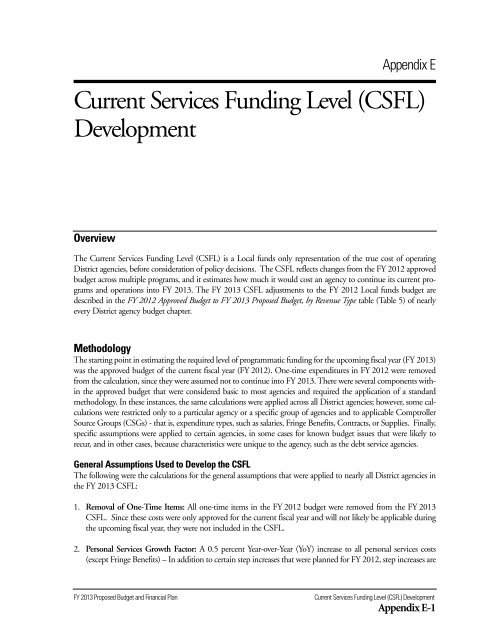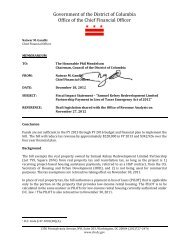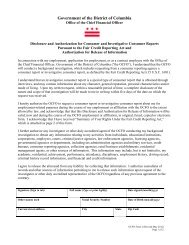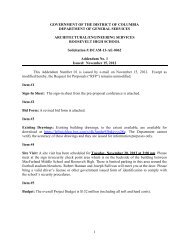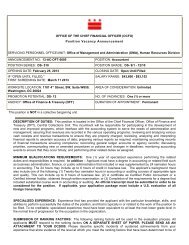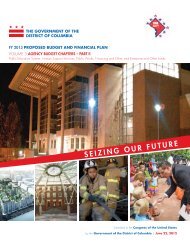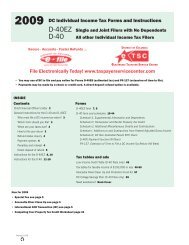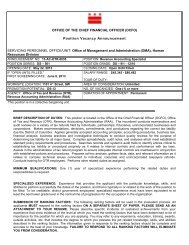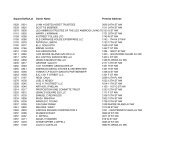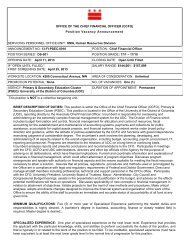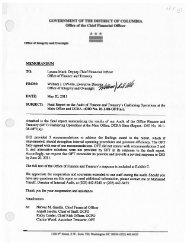Volume 1 - Executive Summary - Office of the Chief Financial Officer
Volume 1 - Executive Summary - Office of the Chief Financial Officer
Volume 1 - Executive Summary - Office of the Chief Financial Officer
You also want an ePaper? Increase the reach of your titles
YUMPU automatically turns print PDFs into web optimized ePapers that Google loves.
Appendix E<br />
Current Services Funding Level (CSFL)<br />
Development<br />
Overview<br />
The Current Services Funding Level (CSFL) is a Local funds only representation <strong>of</strong> <strong>the</strong> true cost <strong>of</strong> operating<br />
District agencies, before consideration <strong>of</strong> policy decisions. The CSFL reflects changes from <strong>the</strong> FY 2012 approved<br />
budget across multiple programs, and it estimates how much it would cost an agency to continue its current programs<br />
and operations into FY 2013. The FY 2013 CSFL adjustments to <strong>the</strong> FY 2012 Local funds budget are<br />
described in <strong>the</strong> FY 2012 Approved Budget to FY 2013 Proposed Budget, by Revenue Type table (Table 5) <strong>of</strong> nearly<br />
every District agency budget chapter.<br />
Methodology<br />
The starting point in estimating <strong>the</strong> required level <strong>of</strong> programmatic funding for <strong>the</strong> upcoming fiscal year (FY 2013)<br />
was <strong>the</strong> approved budget <strong>of</strong> <strong>the</strong> current fiscal year (FY 2012). One-time expenditures in FY 2012 were removed<br />
from <strong>the</strong> calculation, since <strong>the</strong>y were assumed not to continue into FY 2013. There were several components within<br />
<strong>the</strong> approved budget that were considered basic to most agencies and required <strong>the</strong> application <strong>of</strong> a standard<br />
methodology. In <strong>the</strong>se instances, <strong>the</strong> same calculations were applied across all District agencies; however, some calculations<br />
were restricted only to a particular agency or a specific group <strong>of</strong> agencies and to applicable Comptroller<br />
Source Groups (CSGs) - that is, expenditure types, such as salaries, Fringe Benefits, Contracts, or Supplies. Finally,<br />
specific assumptions were applied to certain agencies, in some cases for known budget issues that were likely to<br />
recur, and in o<strong>the</strong>r cases, because characteristics were unique to <strong>the</strong> agency, such as <strong>the</strong> debt service agencies.<br />
General Assumptions Used to Develop <strong>the</strong> CSFL<br />
The following were <strong>the</strong> calculations for <strong>the</strong> general assumptions that were applied to nearly all District agencies in<br />
<strong>the</strong> FY 2013 CSFL:<br />
1. Removal <strong>of</strong> One-Time Items: All one-time items in <strong>the</strong> FY 2012 budget were removed from <strong>the</strong> FY 2013<br />
CSFL. Since <strong>the</strong>se costs were only approved for <strong>the</strong> current fiscal year and will not likely be applicable during<br />
<strong>the</strong> upcoming fiscal year, <strong>the</strong>y were not included in <strong>the</strong> CSFL.<br />
2. Personal Services Growth Factor: A 0.5 percent Year-over-Year (YoY) increase to all personal services costs<br />
(except Fringe Benefits) – In addition to certain step increases that were planned for FY 2012, step increases are<br />
FY 2013 Proposed Budget and <strong>Financial</strong> Plan<br />
Current Services Funding Level (CSFL) Development<br />
Appendix E-1


